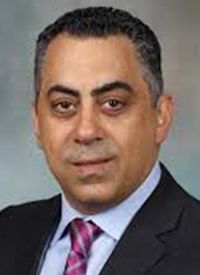Article
Bekaii-Saab Shares Suggested Sequencing Algorithm for Advanced HCC
Author(s):
Tanios S. Bekaii-Saab, MD, FACP, shares his approach for treating patients with HCC across several lines of therapy, as well as factors to consider when making sequencing decisions.
Tanios S. Bekaii-Saab, MD, FACP

As the treatment arsenal for hepatocellular carcinoma (HCC) grows more crowded, the challenge of determining the optimal sequencing of agents for each patient becomes more pronounced, according to Tanios S. Bekaii-Saab, MD, who added that these decisions should be based on available data, as well as patient characteristics and discussions.
“We have seen such a growth of options in the first- and second-line settings in HCC that the landscape has become relatively complex,” said Bekaii-Saab. “[Right now, we need to examine] the available data that support the use of various options and make sense of the complicated landscape in a more simplified way that will help us to optimize how we [treat patients] when moving from first- to second- and, for some, to third-line [treatment].”
In an interview with OncLive® during a 2020 Institutional Perspectives in Cancer webinar on gastrointestinal malignancies, Bekaii-Saab shared his approach for treating patients with HCC across several lines of therapy, as well as factors to consider when making sequencing decisions. He is a medical oncologist at Mayo Clinic, where he is also medical director of the Cancer Clinical Research Office and vice chair and section chief of medical oncology in the Department of Internal Medicine.
OncLive®: How do you approach sequencing the therapies in advanced HCC?
Bekaii-Saab: Ultimately, based on the data that are available in a recent study we published in JAMA Oncology, the standard of care has really shifted to become predominantly a combination of atezolizumab [Tecentriq] and bevacizumab [Avastin], given in the first-line treatment of patients with advanced HCC. Upon progression, 2 options stood out from our network meta-analysis: regorafenib [Stivarga] and cabozantinib [Cabometyx]. With a little bit of my bias, [I would choose] cabozantinib given that it targets MET and AXL, which helps to reverse resistance to VEGF [inhibitors]. However, regorafenib remains a viable option in that setting. In the third-line [setting], cabozantinib [would be a good choice] if you chose regorafenib in the second line.
You could make the case for ramucirumab [Cyramza] in those with alpha-fetoprotein of greater than or equal to 400 ng/mL, [although it] may not be an optimal option for patients who progressed on bevacizumab given the relative overlap in the pure targeting of angiogenesis. Lenvatinib [Lenvima] suffers the same [fate]; it’s primarily a VEGF inhibitor. Lenvatinib has never really been examined [for use] in the second-line [setting] or beyond progression [on a VEGF inhibitor]. Sorafenib [Nexavar] has also not been [evaluated] in the second line in patients who have progressed on prior VEGF-targeted strategies. Frankly, it’s less preferred than regorafenib or cabozantinib in this setting. In some ways, that streamlines the treatment of advanced HCC—going from atezolizumab plus bevacizumab to regorafenib or cabozantinib.
For patients who previously received an agent like atezolizumab, do you believe that rechallenging them with single-agent or combination immunotherapy in the third-line setting would be effective?
We also saw the recent approval of nivolumab [Opdivo] and ipilimumab [Yervoy] in [patients with] refractory disease. This [decision] came on the heels of [patients progressing on] sorafenib. The question is, how would [this regimen] fare following an immunotherapy agent like atezolizumab? Would it be appropriate to consider another checkpoint inhibitor or a combination of checkpoint inhibitors in this setting where a [patient has progressed]? The answer is likely not, pending more data. I do see [this as] a potential path for very few patients; [namely,] those who may have had a good response to atezolizumab/bevacizumab and then, in the second line, received either regorafenib or cabozantinib. In the third-line setting, you could possibly consider rechallenging [them] with immunotherapy, [specifically with] ipilimumab/nivolumab. [This might be an option, but only for] very few patients. [The rationale for this] mainly draws from data [observed in] lung cancer and renal cell carcinoma, where [progression on] a PD-1 or PD-L1 [inhibitor] following a good initial response could [indicate that these patients will respond] to dual checkpoint inhibition. However, that would be an exception; this is very unlikely to [help] many patients.
Could you expand on how the Child–Pugh score is used to determine whether a patient should receive treatment?
Patients with Child–Pugh A [disease] are [the group in which] many of these trials have been performed. [We have seen a] little bit of data with regard to sorafenib, cabozantinib, and nivolumab in [patients with] Child–Pugh B7 [disease]. In my practice, a patient with Child–Pugh B7 [disease] with a fantastic performance status is treated similarly to someone [with] Child–Pugh A [disease].
Beyond that point, the data are [uncertain] as to whether [these patients will derive] any benefit from treatment. I certainly have a very prolonged conversation with patients if their Child-Pugh score is 7 advanced [and they have] borderline performance status or [if they have a score of] 8-minus. Beyond that point, I wouldn’t treat. However, for those patients, I would probably try to deintensify treatment, if I even believe that treatment is reasonable following a discussion.
Latest Conference Coverage

Perioperative Pembrolizumab Regimen Upholds Survival Benefit in Resectable NSCLC

Zongertinib Elicits Durable Responses in Pretreated Advanced HER2-Mutant NSCLC

Lenvatinib Shows Efficacy in Advanced HCC Post-Progression on Atezolizumab/Bevacizumab

Sacituzumab Govitecan Does Not Significantly Improve OS in Pretreated Urothelial Carcinoma
2 Commerce Drive
Cranbury, NJ 08512





